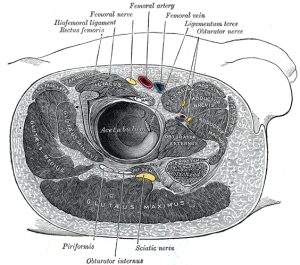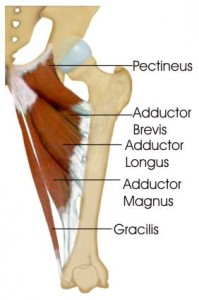The adductor muscles of the inner thighs are an interesting group because not all anatomists agree on their function. I love this. Whether it is for the best or not, I love confusion.
I often tell clients that I intend to confuse them about how they stand and move because, hopefully, new and different patterns might emerge out of that confusion.
The core of what I offer is a basic knowledge of anatomy that makes it a lot easier to learn to walk, correctly use your body, and in particular to heal from injuries small and large.
If you don’t have a natural love of anatomy, a lot of it can truly sound like gobbledygook, but any little bit you take in will serve you in the long run.
There are five adductor muscles—pectineus, gracilis, and adductor brevis longus and magnus.
The essential function of the adductors is to draw the legs towards the midline of the body, but they do different things depending on the position of the legs and pelvis.
They all originate on the pubic rim, though adductor magnus has two heads, one of which attaches to the sit bones, or ischial tuberosities.
The longest of them, gracilis inserts onto the tibia of the lower leg, thereby affecting the knee; the rest insert along the inside of the femur, or leg, bone.
I looked at some of my anatomy texts and saw different explanations for the function of the adductor muscles, which is not something you see very often.
My favorite anatomy book, Thieme’s Atlas of Musculoskeletal Anatomy lists the action of the adductors as having slightly different roles but all of them (excepting gracilis) assist in stabilization of the pelvis. The others all move the legs towards the midline as I mentioned above, but also mix it up a bit with actions including extension, flexion, and external rotation.
Another set of books by John Warfel that I like agrees with Thieme about adduction and flexion but wonderfully reports that “rotation is controversial.”
Other texts list an action of the adductor brevis, adductor longus, and/or adductor magnus as involved with internal  rotation, while others list the action of external rotation.
rotation, while others list the action of external rotation.
An interesting thing to note is that while I consider the adductors, particularly the adductor magnus, because of their connection to the sit bone or ischial tuberosity, to have an important role in setting the thighs back under the hips, which seems like internal rotation, this concept of internal rotation can also be considered abduction (the opposite of adduction) because though the thighs do rotate in from the front, they broaden apart at the back. Confusing enough?
Any way you look at these things, the adductor muscles are involved in almost all pelvic, hip, groin, and psoas problems.
Understanding where they are, and what they do, and developing a balanced tone –they tend to be weaker than their counterparts on the outer leg—are essential to walking and aging well.
The inner thigh muscles are as important as it gets when it comes to developing good walking patterns.

